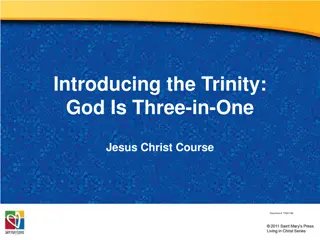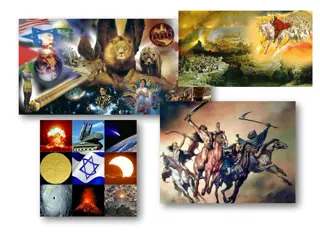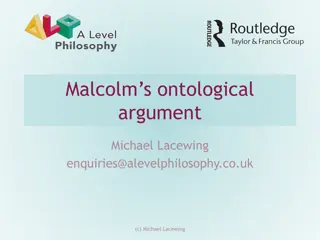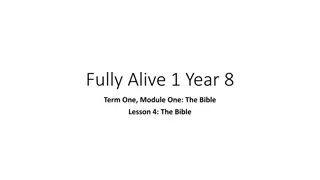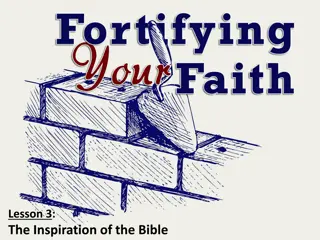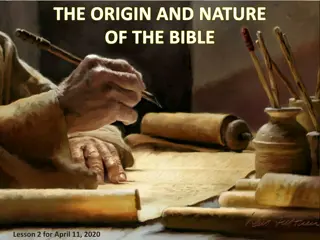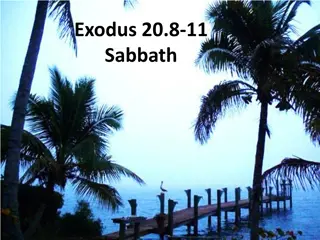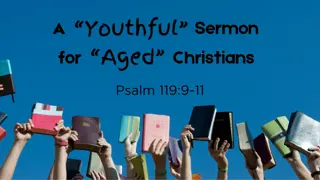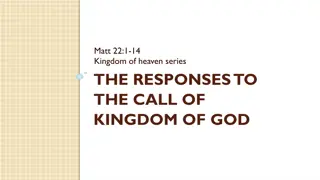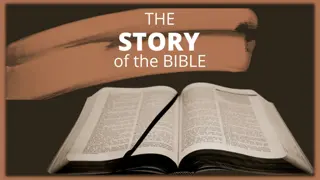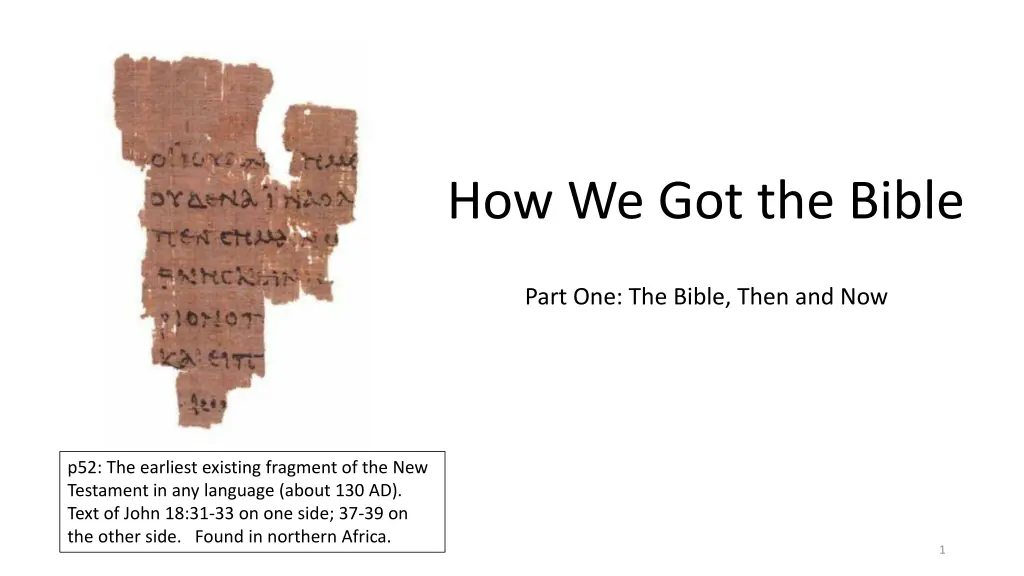
Origin of New Testament Books
Explore the early fragments of the New Testament, why the books were written, content included in the New Testament, and the process of canonization. Discover the historical significance of the New Testament texts and their relevance to Christianity today.
Download Presentation

Please find below an Image/Link to download the presentation.
The content on the website is provided AS IS for your information and personal use only. It may not be sold, licensed, or shared on other websites without obtaining consent from the author. If you encounter any issues during the download, it is possible that the publisher has removed the file from their server.
You are allowed to download the files provided on this website for personal or commercial use, subject to the condition that they are used lawfully. All files are the property of their respective owners.
The content on the website is provided AS IS for your information and personal use only. It may not be sold, licensed, or shared on other websites without obtaining consent from the author.
E N D
Presentation Transcript
How We Got the Bible Part One: The Bible, Then and Now p52: The earliest existing fragment of the New Testament in any language (about 130 AD). Text of John 18:31-33 on one side; 37-39 on the other side. Found in northern Africa. 1
Why Were the Books of the New Testament Written? Why Were the Books of the New Testament Written? Issues to resolve and challenges to address: potential and new converts had questions The Great Commission (Acts 1:8). Jesus tells his disciples to proclaim the good news (Gospel) throughout the world. As the disciples went out from Jerusalem and began to establish churches they needed accounts of the life of Jesus and his work in the world, so people who had never met him could come to know him and believe in him (John 20:21). Who was Jesus? What is his relation to God? How can Jesus be the Messiah if he died? What is the meaning of the Resurrection? Where is he now? What did he do for me, and how does what he did save me? How is he present with me now? Why do we still suffer? How do I become a Christian and live as a Christian? What is eternal life? What does it mean to be filled with the Spirit of God ? There were thousands of Jews in Jerusalem who believed in Jesus and were zealous for the law (Acts 21:20): o What is the relationship of Christianity to Judaism? How does the Hebrew Bible (Scripture) function in the life of a Christian? Where should I go, the church or the temple/synagogue? This issue was particularly acute after the destruction of Jerusalem (AD 70), when Jews were dispersed into areas where the church and synagogue were separate. o What is the Christian s relation to the Law? How much of the Law do Christians who are not Jews have to keep? How can we say that the Messiah has come when sin and death remain? How will God ultimately win? What should I do while waiting for Jesus to return? How should the church be organized? What is the role of women in the church? Who gets included? What should be the church s attitude be toward the poor? 2
The New Testament The New Testament The NT includes 27 books: the four canonical gospels (Matthew, Mark, Luke, and John), the Acts of the Apostles, the fourteen epistles of Paul, the seven catholic epistles, and the Book of Revelation. All NT books were originally written in koine Greek (the common language of the people, as opposed to classical Greek. Koine Greek was spoken and read throughout the Roman world, where most people were trilingual (Greek, Latin, and the local language, which in Palestine was Aramaic). All NT books were in circulation throughout the church from northern Africa around to Spain and Gaul (France) by AD 100-120. The texts are quoted by Early Church Fathers dispersed throughout the Roman empire, whose writings have survived. The transmission of the original texts required making several handwritten copies, which may have been done when the text was originally written, and taking them by a courier to the churches. None of the original texts (autographs) survive. Other Christian books or letters were written during this early period of the Church, but did not make it into the canon (some may have been lost, see Luke 1:1; some have survived, Gospel of Thomas, Shepherd of Hermas, The Acts of Paul and Thecla, The Epistle of Barnabas, 3rdCorinthians, Paul s Letter to the Laodiceans). Decisions about which book should be included in the NT Canon were finalized in the 4th century AD. The earliest known complete list of the 27 books of the New Testament is found in a letter written by Athanasius, a 4th-century bishop of Alexandria, dated to 367 AD. To be discussed in the next class. 3
The Hebrew Bible and the First Christian Writings The Hebrew Bible and the First Christian Writings Fundamentally different attitudes of Jews vs. Christians toward their writings: reverence vs. respect The Jews are sustaining the bureaucracy of an established institution. They considered their writings sacred (unchangeable; they were rigorously accurate in copying their scriptures through the ages). The Dead Seas Scrolls, which contain all OT books, except Esther, were virtually unchanged for 1000 years. The early Christians evangelistic thrust into the world required that their writings be understood in diverse cultures, among both Jews and Greeks, who had unique questions and responses to the Good News. Therefore, the early Christians showed flexibility and diversity in how they wrote, copied and transmitted their writings. Currently we have recovered approximately 5800 manuscripts or fragments of the various New Testament books (including fragments of single books, single books, collections of letters, complete or nearly complete Bibles ). Every version differs from the others. Often the differences are minor and insignificant (e.g., spelling mistakes) and none of the differences have doctrinal significance. But the differences do reflect that the early Christians exhibited freedom to change the original text to help the reader understand it. Such changes might have occurred at the very beginning, as the original authors or their associates made copies of the Gospels or letters to be delivered to particular churches in disparate parts of the Greco-Roman world (e.g., the Book of Acts in Western tradition is 8% longer than the version in Alexandria both versions are very early). 4
Text Types After the various NT books were written, they were copied and taken to the parts of the Greco-Roman world where churches had been established. Three major families of texts, related to specific locations and time periods have been found. Each has unique characteristics: Byzantine Text Western Text Alexandrian Texts: Early Church tradition tells us that Mark founded the church in Alexandria. The texts found and associated with this region are the earliest and closest to the original documents. Western Texts: the texts found here are later than the Alexandrian texts and often reflect paraphrases of the originals or add information missing from them. Byzantine Texts. These texts represent 95% of the NT texts we have and are the farthest removed from the originals (5th century and later). Characterized by harmonization, paraphrase and additions to originals Alexandrian Text 5
Three Major Text Families Three Major Text Families Text type Date Characteristics Bible version This family constitutes a group of early and well-regarded texts, including Codex Vaticanus and Codex Sinaiticus. Most representatives of this tradition appear to come from around Alexandria, Egypt and from the Alexandrian Church (church founded by Mark). It contains readings that are often terse, shorter, somewhat rough, less harmonized, and generally more difficult. The family was oncethought to result from a very carefully edited 3rd-century recension, but now is believed to be merely the result of a carefully controlled and supervised process of copying and transmission. It underlies most translations of the New Testament produced since 1900. Also a very early tradition, which comes from a wide geographical area stretching from North Africa to Italy and from Gaul to Syria. It occurs in Greek manuscripts and in the Latin translations used by the Western church. It is much less controlled than the Alexandrian family and its witnesses are seen to be more prone to paraphrase and other corruptions. It is sometimes called the Caesarean text-type. Some New Testament scholars would argue that the Caesarean constitutes a distinct text-type of its own. This group comprises around 95% of all the manuscripts, the majority of which are comparatively very late in the tradition. It had become dominant at Constantinople from the 5th century on and was used throughout the Eastern Orthodox Church in the Byzantine Empire. It contains the most harmonistic readings, paraphrasing and significant additions, most of which are believed to be secondary readings. It underlies the Textus Receptus used for most Reformation-era translations of the New Testament. The Alexandrian text-type (also called the "Neutral Text" tradition; less frequently, the "Minority Text") NIV, NAB, NABRE, Douay, JB and NJB (albeit, with some reliance on the Byzantine text- type), TNIV, NASB, RSV, NRSV,ESV, EBR, NWT, LB, ASV, NC, GNB, CSB 2nd 4th centuries CE Vetus Latina (basis for the Vulgate or Latin Version of the NT) The Western text- type 3rd 9th centuries CE The Byzantine text- type; also, Koin text-type (also called "Majority Text") KJV, NKJV, Tyndale, Coverdale, Geneva, Bishops' Bible, OSB 5th 16th centuries CE 6
The Synoptic Gospels The Synoptic Gospels Matthew, Mark, and Luke are similar and sometimes parallel (Synoptic = viewed together ), but each tell the story of Jesus life in ways that relate to the particular needs and culture of their readers. Matthew: Writes for a Jewish Christian audience living in proximity to Jerusalem (five sections of Matthew correspond to five books of the Torah, Jesus portrayed as the new Moses, sermon on the mount parallels the giving of the law to Moses on the mountain, Kingdom of Heaven vs. Kingdom of God). Mark the Evangelist (Acts 12:12; 15:37), an associate of St. Paul and a disciple of St. Peter, whose teachings the Gospel may reflect. It is the shortest and the earliest of the four Gospels, probably written during the decade preceding the destruction of Jerusalem in 70 CE. Early Church Fathers identify Mark as the founder of the Church in Alexandria. Luke and the Book of Acts are closely related, most likely written at the same time on two different scrolls. Written by the same author and for the same purpose, both were addressed to a Christian named Theophilus and were designed to present to him a complete and well-authenticated narrative of the life of Jesus and the early history of the Christian movement. Luke travelled with Paul and. according to the last chapters of Acts, accompanied him to Rome where Paul was to be on trial before Caesar. Theophilus may have a Roman Christian involved in Paul s defense. Other theories related to Theophilus s identity have been proposed; none are generally accepted by scholars. 7
The Synoptic Gospels: The Use of Sources The Synoptic Gospels: The Use of Sources Luke tells us that by the time he writes his Gospel many had written about Jesus (Luke 1:1-4): Many have undertaken to write an account of the things that have been fulfilled among us, just as they were handed down to us by those who from the first were eyewitnesses and servants of the word. With this in mind, since I myself have carefully investigated everything from the beginning, I too decided to write an orderly account for you, most excellent Theophilus, so that you may know the certainty of the things you have been taught. Oral tradition: standardized ways or forms in which the stories of Jesus were told (handed down) before the stories were written down (parables, miracles, sayings). Contexts would be early Christian preaching and teaching. John states that what he writes is only a partial representation of all the things that Jesus did and were witnessed by his disciples (John 20:30). Who wrote first? Who depended on whom? Were there sources that were used that were lost? Why is John s Gospel so different from the others? These questions and others form the basis for what has been called the Synoptic Problem. 8
The Inter The Inter- -relationship of the Synoptic Gospels relationship of the Synoptic Gospels Mark wrote first, perhaps based on the recollections of Peter, and was used as a source by both Matthew and Luke Quelle an early document, now lost, that contained only sayings of Jesus that appear only in Luke and Matthew, not in Mark Q Mark Information available only to Matthew Information available only to Luke Matthew Luke Each author is not simply copying from their sources, but is authoring a unique story for a particular audience based on sources that were available to them. See Luke 1:1, Many have undertaken to write about the things that have been fulfilled among us. 9
Why is John Different? Why is John Different? Significant differences between John and the Synoptic Gospels: Omission of material: temptation, transfiguration, Lord s Supper, Sermon on the Mount, Lord s Prayer, no parables. Inclusion of material not in Synoptics: farewell discourse (John 13-17), Jesus career spans 3 years rather than 1; he makes three visits to Jerusalem before passion; early ministry in Galilee (Jn 2-4; story of the raising of Lazarus. Higher Christology: Jesus is the Word of God, pre-existing with God, Thomas calls Jesus, My Lord and my God (John 20:28). Jesus identity not hidden from disciples during Jesus ministry as in Mark. Extended discourses rather than short saying and parables Kingdom of God vs Eternal Life. Kingdom of God (Mt, 55x; Mk, 22x; Lk 46x; John, 5x); Eternal Life (Mt, 7x; Mk 4x; Lk 5x; John 36x). John s Jesus is not described as one who announces the Kingdom of God on earth, but as the One sent by God to proclaim eternal life to the world that God loves (John 3:16) 10
Why is John Different? Why is John Different? John was addressing a raft of contemporary challenges facing the church (Jewish and Gentile Christians) at the end of the first century (AD 90). These may have included the need to arm believers against heretical teachings about Jesus (e.g., Jesus never had a human body, so his suffering was not real [Docetism]; Jesus was unrelated to the God of the Hebrew Bible [Gnosticism]), and encourage faithfulness in the face of the final break with the synagogue. Another more speculative notion involves correction of an alleged tendency among the followers of John the Baptist to deny Jesus Messianic claims. To have his message make sense to people who were not Jews or had separated from Judaism, John may not have used Jesus exact words (ipsissima verba), but wrote faithful summaries and interpretive paraphrases (ipsissima vox) of what Jesus actually said in ways that his audience could understand. At the conclusion of his Gospel, John says, Jesus did many other miraculous signs in the presence of his disciples, which are not recorded in this book. But these are written so that you may believe that Jesus is the Christ, the Son of God, and that by believing you may have life in His name (John 20:30 31). John may have had direct eyewitness material that the other Gospel writers did not have (John 20:24-25), and perhaps did not consider it necessary to include what the other Gospel writers had already written. His primary purpose was to inspire and sustain the faith of those who read his words. 11
The Use of Amanuenses in the Writing of NT Letters The Use of Amanuenses in the Writing of NT Letters Originating during the period of the OT prophets (Isaiah 8:16, Jeremiah 36:4), an amanuensis was often used to write down the thoughts of the author. The author would normally read what the amanuensis wrote, approve it and write a personal note at the end with his mark or signature. This practice continued in the letters of Paul and Peter. An amanuensis differed from a scribe in that scribes would make word for word copies of documents, while an amanuensis would function as a thought partner, working with the author to ensure that his ideas were communicated effectively (more like a personal secretary). Romans 16:22: I, Tertius, who wrote this epistle, salute you in the Lord. 1 Corinthians 16:21: I, Paul, write this greeting with my own hand. Colossians 4:18: I, Paul, write this greeting with my own hand. Remember my chains. Grace be with you. Philemon 19: I, Paul, am writing this with my own hand: I will repay it. I say nothing about your owing me even your own self. 2 Thessalonians 3:17: I, Paul, write this greeting with my own hand. This is the mark in every letter of mine; it is the way I write. Galatians 6:11: See what large letters I make when I am writing in my own hand! Some have speculated that Paul needed an amanuensis due to poor eyesight. 1 Peter 5:12: Through Silvanus, whom I consider a faithful brother, I have written this short letter to encourage you and to testify that this is the true grace of God. Stand fast in it. While there is no way to confirm this, based on the internal evidence of the epistles and the statement of the early Church Fathers, the amanuenses of Paul may have been: Tertius (Romans); Sosthenes (1 Corinthians); Timothy (2 Corinthians, Philippians, Colossians, 1 and 2 Thessalonians, Philemon); Silvanus or Silas (1 and 2 Thessalonians) and Luke (1 Timothy, 2 Timothy, Titus, and Hebrews). As the Gospel of Mark nowhere identifies its author as Mark, some consider Mark to have been Peter s amanuensis, who wrote down Peter s recollections of the ministry of Jesus. 12
How is the Bible Authoritative for Us? How is the Bible Authoritative for Us? What is the meaning of Inspiration? After Jesus, God sent the Spirit. The Spirit s role in our lives is to be God present with us, in us and surrounding us, guiding, empowering and animating our thoughts and our experience of life. Inspiration literally means God breathes life into us. When we feel inspired, the experience we have (knowing and feeling) is derived from God, who provides meaning and purpose within the ordinary experience of our lives. It is in this sense that the Bible is inspired. The Bible is not God. We don t worship the Bible. But we derive inspiration from the Bible as we meet God here, learn how God introduced himself to us uniquely in Jesus Christ and how God continues to work in his people, so that today we can recognized God, be inspired by God in our lives, and have a transformative impact on the world. We believe that the writers of the New Testament had a profound relationship with God, had experienced God uniquely in Jesus Christ, and had given a tremendous amount of thought to what this meant. We believe that as we can know God today, in relationship with God and influenced by God s Spirit, the NT authors wrote down their thoughts to address specific issues that they and the churches they served faced. To believe in inspiration does not require that we believe that every word in the Bible was dictated to the authors by God. It does mean that what is there represents their best thinking as, in prayer and interaction with God s Spirit, their thoughts we guided by God s Spirit. 13
How is the Bible Authoritative for Us? How is the Bible Authoritative for Us? What is the meaning of Inerrancy? Tremendous disagreements about what this means: The Bible has no errors. The Bible has no errors in the original documents. Where the term inerrancy refers to what the Holy Spirit is saying to the churches through the biblical writers, the church can support its use. Where the focus switches to an undue emphasis on matters like chronological details, precise sequence of events, and numerical allusions, we should consider the term misleading and inappropriate. The Bible is infallible in matters related to faith and practice, but is not inerrant. The concept of inerrancy came into Christianity in the late 19th century, where theologians at Princeton Theological Seminary (Warfield and Hodge), resisting a new claim that the Pope was infallible, wanted to affirm the infallibility of the Scriptures over that of the Pope. Not a core doctrine before that (not in Luther or in the early Church fathers). What counts as an error? The Lord s Prayer in Matthew vs. Luke (next slide) 14
The Lords Prayer: What Did Jesus Say? The Lord s Prayer: What Did Jesus Say? Matthew 6:9-13 (NRSV) Luke 11:2-4 (NRSV) Our Father in heaven Father hallowed be your name. hallowed be your name. Your kingdom come. Your kingdom come. Your will be done, on earth as it is in heaven. Give us this day our daily bread. Give us each day our daily bread. And forgive us our debts, as we also have forgiven our debtors. And forgive us our sins, for we ourselves forgive everyone indebted to us. And do not bring us to the time of trial, but rescue us from the evil one. And do not bring us to the time of trial. For the kingdom and the power and the glory are yours forever. 15
Inadequate Approaches to Biblical Authority Inadequate Approaches to Biblical Authority The Biblicist s approach. The Bible is authoritative because its origins are supernatural. All the words of the Bible are God s words. This levels the importance of every passage in the Bible. For example what Paul says about women being silent in the Church (1 Timothy 2:12) is equal to what he says about the equality and communion of all who are in Christ: no male vs. female, no slave vs. free, all are one in Christ (Galatians 3:28). This view of the Bible does not allow Scripture to work as a liberating word in its own way. Contrary to this view, based on the liberating message of the Bible, and influenced by God s Spirit, the church continues to address issues not covered in the Bible. The Bible as an historical source. The scholarly search for what is factual in the Bible (e.g., the new quest for the historical Jesus), begins to eliminate anything as relevant for faith that cannot be historically validated. This approach ignores the reality experienced by the majority of Christians, that just reading the Bible as it appears in our current versions, has brought them into a relationship with God that has had a transformative impact on their lives. The historical approach is important for understanding the text, but the authority of Scripture does not stand or fall based on its findings. The Bible as a religious classic. This is the approach taken by many college and universities. For Christians, however, the Bible is not just great literature. God is not just the main character in a story captivatingly told, Jesus is not just an impressive but puzzling figure. This approach rejects what Christian affirm: the Bible is a normative witness to the acts of the living God for our salvation. The Bible is a private devotional text. While this view the Bible as a guide and source of life for me, is certainly legitimate, it is a distortion when the Bible is separated from its meaning for us, or for the world. 16
Paul Feiler 713-256-9039 pfeiler51@gmail.com Call me if you want to talk about this How the Bible Is Authoritative for Us How the Bible Is Authoritative for Us Since the beginning of the Christian Church, the Bible has been considered an authority for Christian faith. During the Reformation, for Luther and Calvin, the authority of the Bible was grounded in its liberating message of God s gracious acceptance of sinners offered in Jesus Christ, as opposed to the arbitrary or despotic authority found in the Church and the way it used the Bible as a tool of control. Thus Luther could speak of the Bible with these words, Everything that does not attest to the Gospel set forth in Jesus Christ is straw. The authority of Scripture is related to the way it functions in the Christian Church and in the life of the Christian. It is for us the unique and irreplaceable witness to the liberating and reconciling work of God in the history of Israel and supremely through Jesus Christ. By the power of the Holy Spirit, it serves the purpose of relating us to God and transforming our life. A true witness does not call attention to itself, but to the thing it witnesses. The Bible is the Word of God only in a derivative sense. The living Word of God is Jesus Christ (as it was from the beginning) and it is through him that we are brought into relationship with God. Scripture is therefore authoritative not in itself, but only as it bears witness to Jesus Christ. 17



